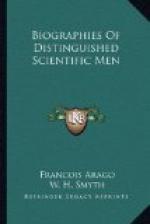Sir William Herschel’s catalogues of double stars offer a considerable number to which he ascribes a decided green or blue tint. In binary combinations, when the small star appears very blue or very green, the large one is usually yellow or red. It does not appear that the great astronomer took sufficient interest in this circumstance. I do not find, indeed, that the almost constant association of two complementary colours (of yellow and blue, or of red and green), ever led him to suspect that one of those colours might not have any thing real in it, that it often might be a mere illusion, a mere result of contrast. It was only in 1825, that I showed that there are stars whose contrast really explains their apparent colour; but I have proved besides, that blue is incontestably the colour of certain insulated stars, or stars that have only white ones, or other blue ones in their vicinity. Red is the only colour that the ancients ever distinguished from white in their catalogues.
Herschel also endeavoured to introduce numbers in the classification of stars as to magnitude; he has endeavoured, by means of numbers, to show the comparative intensity of a star of first magnitude, with one of second, or one of third magnitude, &c.
In one of the earliest of Herschel’s memoirs, we find, that the apparent sidereal diameters are proved to be for the greater part factitious, even when the best made telescopes are used. Diameters estimated by seconds, that is to say, reduced according to the magnifying power, diminish as the magnifying power is increased. These results are of the greatest importance.
In the course of his investigation of sidereal parallax, though without finding it, Herschel made an important discovery; that of the proper motion of our system. To show distinctly the direction of the motion of the solar system, not only was a displacement of the sidereal perspective required, but profound mathematical knowledge, and a peculiar tact. This peculiar tact Herschel possessed in an eminent degree. Moreover, the result deduced from the very small number of proper motions known at the beginning of 1783, has been found almost to agree with that found recently by clever astronomers, by the application of subtile analytical formulae, to a considerable number of exact observations.
The proper motions of the stars have been known and proved for more than a century, and already Fontenelle used to say in 1738, that the sun probably also moved in a similar way. The idea of partly attributing the displacement of the stars to a motion of the sun, had suggested itself to Bradley and to Mayer. And Lambert especially had been very explicit on the subject. Until then, however, there were only conjectures and mere probabilities. Herschel passed those limits. He himself proved that the sun positively moves; and that, in this respect also, that immense and dazzling body must be ranged among the stars; that the apparently inextricable irregularities of numerous sidereal proper motions arise in great measure from the displacement of the solar system; that, in short, the point of space towards which we are annually advancing, is situated in the constellation of Hercules.




